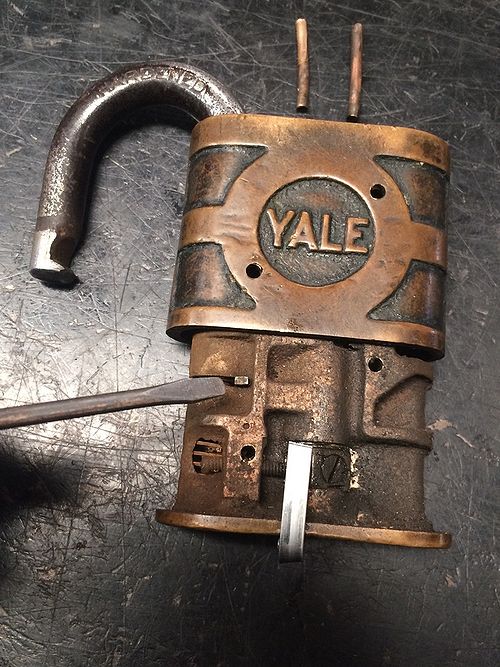Yale 850
Yale 850
| Yale 850 | |
 | |
| Name | Yale 850 |
|---|---|
| Manufacturer | Yale |
| Lock Type | Padlock, Cylinder |
| Lock Design | Pin-tumbler |
| Specifications | |
| # of Components | 6 |
| Component Type | Pin-tumbler |
The Yale 850 Padlock is a pin-tumbler padlock made by Yale. It is a solid body padlock with an inner cylinder.
Principles of operation
This padlock cylinder is a pin-tumbler lock. The key only turns clockwise to open the lock.
Disassembly instructions
This padlock cannot be disassembled non-destructively. However, there are only two pins which need the heads drilled off for disassembly. The pins can be replaced.
Unlock the padlock, then drill the heads off the body retaining pins.

Use a drift punch to drive out the pins.

Remove the shackle retaining pin, located here.

Pull shackle out and lift off lock body.

Remove plug retaining plate screw and plate.

Push plug down slightly to release locking dogs.

Locking dogs in locked position.

Locking dogs in released position due to plug being lowered.

Remove locking dogs and springs by sliding them outwards.

Use a follower to push out the plug.

Remove actuator by lifting it off the end of the plug.

Remove follower and sort out pins onto tray. You will notice that the key pins have heavy wear.
The driver pins are not worn - that is how the factory used to hand-make mushroom driver pins.

New retainer pins look like this.

Slide them into place after reassembly.

Flip the lock over and you will see the ends of the retainer pins sticking out.

At this time, you would hammer the ends of the retainer pins so they mushroom out, tightening both sides. Then you would file the excess off and sand them flat to blend them into the lock body.



